Jakarta, the capital of Indonesia, is a chaotic metropolis. One of the world’s most overpopulated urban region; the city suffers from the huge burden of snarling traffic, polluted environment, sinking ground and boundless ambitions. Somewhere behind the glitters of its gigantic shopping malls, it fails to reveal its true character. After spending three nights in the chaos, confusions and surprises of Jakarta City; I was desperate to reach Yogyakarta; the cultural hub of Java Island. Yogyakarta; The Gateway to iconic Borobudur, everlasting Prambanan and volcanic Mount Merapi!
Contents
1. Jakarta To Yogyakarta Trains
2. Railway Stations in Jakarta
1. Jakarta To Yogyakarta Trains
I always love the train journeys and thoroughly enjoyed my train travels in India, Egypt and Thailand. The memories of the epic Trans-Siberian Journey in Russia are still fresh in my mind. The trains don’t merely get you to the destinations cheaply. They also connect you to the soul of that country, their local people, their unique culture, their day to day life; a genuine sense of connection usually not possible during a flight trip.
There were two options to travel from Jakarta to Yogyakarta, either a train journey for nine hours or a flight trip for one hour. It wasn’t a hard choice, a flight ticket any day. But Java Island is not an ordinary destination.
I read so much about the scenic train journey from Jakarta to Yogyakarta; that I didn’t think twice before making my choice; a day-time train journey through the spectacular paddy fields, gorgeous mountains and fascinating rural life of Java Island.
Day Journey or Night Journey
It depends on the preferences. Generally, each train leaving from Jakarta to Yogyakarta covers the 530 kms distance in about 8-9 hours. Whatever train you choose e.g. night train, day train, executive class train or economy class train; they mostly run on time. Day and Night, both journeys have some pros and cons, but if you ask me I would recommend a day-time journey always.
Benefits of Night Train:
a) You can utilize your day-time in Yogyakarta.
b) It saves one day cost of the hotel at Jakarta.
c) You get sufficient time to reach Borobudur and Prambanan on the same day.
None of the train between Jakarta and Yogyakarta has sleeper berths, therefore there is no chance of stretching your legs during the night sleep. However, Executive class seats are a bit more comfortable than the others.
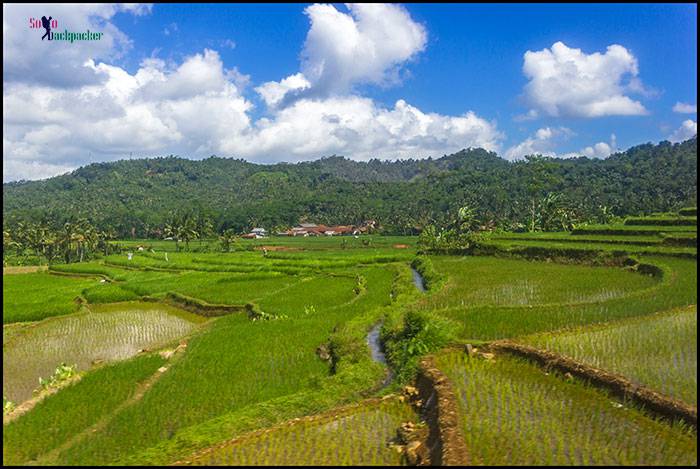
Another problem with the night train is an early arrival at Yogyakarta. Executive Class night trains from Gambir Station in Jakarta arrive early in the morning at Tugu Yogyakarta Station between 0300 AM and 0430 AM. Economy Class night trains from Pasar Senen Station in Jakarta arrive in the morning at Lempuyangan Station in Yogyakarta between 0600 and 0700 AM.
Most of the hotels and hostels in Yogyakarta don’t allow an early check-in. Standard check-in time is 1200 PM. You must coordinate with them for an early arrival, so that they can arrange a pick-up and early check-in. They may request you to pay for an extra day in the case of an early check-in, cancelling out your one day saving in Jakarta. You may also get some sort of transportation on your at Yogyakarta, but in the early morning hours, it is a challenging task. It may leave you on the mercy of touts.
Benefits of Day Train:
a) Day-time journey is absolutely fantastic with the view of scenic paddy fields, gorgeous mountains and fascinating rural life.
b) Easy to interact with fellow travellers.
c) Check-in to the hotels/hostels easily.
The only problem with the day train is you have to move quickly for Borobudur, if you want to reach same day using public transport.
Executive Class or Economy Class
In India, the trains are divided in various categories like Passenger, Express, Superfast etc and travel time between the cities typically depends on the train category. A single train has few types of coaches like General, Sleeper, Third AC, Second AC, First Class, etc. Some trains have only one or two types of coaches.
In Indonesia, the train category is defined by the ticket class only and there are mainly two ticket classes:
Executive (First) Class: The expensive one and the highest available class on a train in Indonesia. Fully air conditioned. Four seats in a row (two seats left side, two seats right side and a corridor in-between). The seats normally face the front side, but they can rotate to face the back side, so these seats are ideally suitable for the family/groups. All seats have footrests, inclining backrests and cushions. You can recline the seats in Executive Class. While booking tickets, you can see subclass A, H, I, J with different prices. Actually, all these are similar, but merely differ in the prices like a flight ticket, where prices vary according to the seat location inside the aircraft.
If you are interested in the Train Journeys, you should read about an epic train journey in Russia: Trans-Siberian Rail Journey in Russia
Economy (Third) Class: The cheaper one. Most of the trains are fully air conditioned, few are not. Two rows of seats with a corridor in-between. Front and Back facing seats. Each seat can accommodate two passengers. While booking tickets, you can see subclass C, S, Q, P with different prices. These are also similar and only differ in the prices like a flight ticket, where prices vary according to the seat location inside the aircraft.
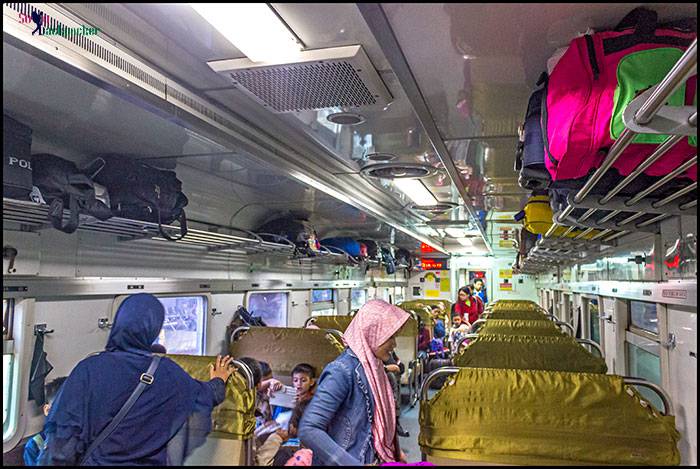
Sometimes, you may find a train class termed as Business (Second) Class. In terms of the comfort, it is somewhere between the Executive Class and the Economy Class. The seats are easy to recline in Business Class too. Most of the trains between Jakarta and Yogyakarta don’t have this class now.
It’s extremely rare that a particular train has more than one type of classes. Therefore, an Executive class train has all the coaches as the Executive Class and an Economy Class train has all the coaches as the Economy Class. The trains can be identified by their name following by a number like Gajahwong 164, Taksaka Malam 54 etc.
The Economy Class train is fully air-conditioned and nice enough to experience a pleasant journey, however, the Executive Class trains are mostly used as a relaxed way of travelling. The Economy Class trains have more stoppage than the Executive Class trains, so the travel time for Economy Class train is 1 hour to 2 hours more.
The ticket prices for the Economy Class train vary from 70000 IDR to 270000 IDR, while for the Executive Class, the ticket prices vary from 260000 IDR to 430000 IDR. The ticket prices also vary with the availability status and the date of the journey. In my opinion, Economy Class train is a decent option to travel between Jakarta and Yogyakarta.
2. Railway Stations in Jakarta
There are mainly two railway stations in Jakarta from where you can board a train to Yogyakarta. It depends on the class of your journey ticket. All Executive Class trains depart from Gambir Station (GMR) in Jakarta and arrive at Tugu Yogyakarta (YK) station in Yogyakarta. All Economy Class trains depart from Pasar Senen Station (PSE) in Jakarta and arrive at Lempuyangan (LPN) station in Yogyakarta.
Gambir Railway Station
Gambir Railway Station is the main and the largest railway station in Jakarta. The station building consists of three floors. The First floor is basically a shopping concourse with many food restaurant, mini market and ticket counters. The second floor is for passenger waiting area and again a mini market with restaurants and merchandise shops. The third floor is for the trains where four platforms of the Gambir station is used for arrival and departure.
Gambir station is situated near the National Monument (Monas) and easy to reach in comparison to Pasar Senan. DAMRI buses from Gambir Station to Jakarta Airport run everyday from 0100 AM to 0900 PM. Many local modes of transports like buses, minibuses, taxis and TransJakarta buses are easily available for Gambir Station.
Mostly Executive Class trains operate from Gambir station to Yogyakarta. Important trains are Argo Dwipangga 10 (0800 AM, up to Solo Balapan), Taksaka Pagi 52 (0830 AM), Bima (0430 PM), Gajayana (0540 PM), Argo Lawu 8 (0815 PM, upto Solo Balapan), Takasaka Malam 54 (0845 PM) and Argo Lawu 8F (0915 PM, upto Solo Balapan). These all are Executive Class trains.
The Indonesian Railway is planning to shift the main railway station of Jakarta from Gambir station to Manggarai Station in South Jakarta by 2022 for the long-distance trains. The Gambir Station will be left to serve commuter line and special trains.
Pasar Senen Railway Station
Pasar Senen is the second largest station in Jakarta. It is mainly served by Economy and Business Class Trains. Due to the Economy class trains, the stations is always packed with the passengers. It is advisable to arrive at Pasar Senen at least 30 minutes before the departure time to catch a train.
Important trains on Yogyakarta route are Gajahwong 154 (0645 AM), Gaya Bari Malam Selatan 174 ( 1015 AM), Bengawan 184 (1120 AM), Singasari 156 (1225 PM), Senja Utama YK 120 (0700 PM), Bogowonto 152 (0945 PM), Senja Utama Solo 116 (Business Class, 1000 PM, up to Solo) and Progo 186 (1020 PM).
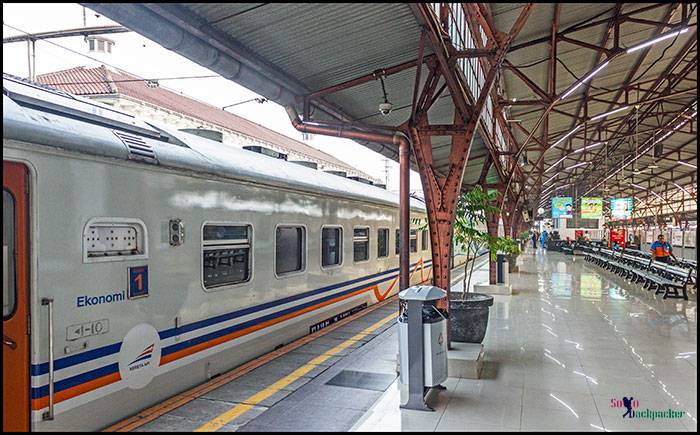
In Yogyakarta, Tugu station is in the center, few minutes away from Maliboro Street, always busy irrespective of the time and lot of backpacker hostels/hotels are in the vicinity. However, Lempuyangan station is also not too far, hardly 3 kms away. Catching a train from Gambir and leaving at Tugu is the best option for smooth journey, but the ticket price is relatively higher. They journey from Pasar Senan to Lempuyangan is cheaper because of the economy train tickets.
3. Online Ticket Booking
It is possible to book the train tickets online. Ticket reservations can be made starting 90 days in advance. You can make a reservation for maximum 4 people at a time. Indonesian railway official website is useful to buy the tickets online. However, as a foreign traveller, I found tiket.com more useful for online ticket booking with a small transaction fee. Both websites charge 7500 IDR convenience fees while booking the tickets online. It is always advisable to book the ticket in advance, particularly during the holidays time.
The online tickets can also be procured at many Indomaret and Alfamart Superstores situated across the country. They demand a modest fee for the ticket booking. The offline tickets can be purchased from the ticket booking counters at the railway stations.
4. Ticket Printing Machines
The online tickets booked on the official railway website, tiket.com, Indomaret stores or booked through any other sources are not valid for the journey. After booking, you will get a reference number (kind of PNR number). The e-tickets must be redeemed with the physical railway ticket, an orange ticket, before embarking on the journey.
There are many ticket exchange counters at the railway stations. Apart from the ticket exchange counters, many ticket printing machines are also available. The ticket printing machines are like self-service kiosks, where you can print orange tickets without any help by using your reference number.
If you buy ticket offline before 3 days of the journey from the booking counter at the stations, then you get a blue ticket, and within 3 days of the journey, then you get an orange ticket. The orange ticket is valid for the journey, and you can straight board the train. But the blue ticket must be redeemed at the ticket printing kiosks, just like online tickets, before the commencement of the journey.
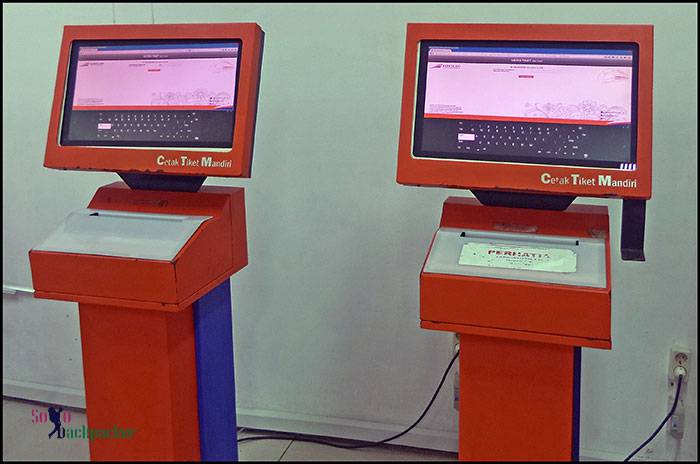
5. Train Journey From Jakarta To Yogyakarta
I travelled from Pasar Senan Station, Jakarta to Lempuyangan Station, Yogyakarta on a day-time Economy Class train in the month of Eid-Al-Fitr. Due to the sacred month, there was a huge rush outside the main terminus building. Fortunately the ticket printing machines (kiosks) were not crowded like the entrance. I quickly printed a ticket and reached to the terminus entry gate.
Every year, in month of the Eid-Al-Fitr; thousands of Indonesian people travel from their workplaces, colleges and universities to their hometowns and villages to celebrate the holy month with their families. The mass movement of the people from one place to another is known as Mudik. The Mudik exodus causes a huge chaos across Indonesia, at the roads, at the railway stations, at the airports, etc.
However, during my trip the sacred month was just started, and the situation was relatively better than the Mudik. Nobody was allowed to go inside without a valid ticket. It means, only the genuine travellers can access the platforms in Indonesia. This is a nice thing and makes the platforms less congested that, in turn, keeps them pleasantly neat and clean.
Another Train Journey in India: An Unforgettable Journey on Kalka – Shimla Railways
When I reached to the platform, a train was already there. The exterior of the train wasn’t attractive, but when I entered in the coach, it was surprisingly good inside; very neat and clean look. The train was full of passengers. But there was nothing like passengers standing in the alleys, near the doors, cramming through the coach corridors, etc. Everyone had a prior booking to occupy their respective seats.
The journey started on time. After two hours of a journey through the urban expansion of Jakarta Megapolis, the train passed through a series of lush green carpet appeared on the both sides of the railway track. The paddy fields, occasionally appeared barley fields, palm and banana plantations; the constant changing landscapes from one moment to the next; forced me to exchange my seat with a fellow traveller who was having better views outside the train window.

There is no food and water facility in the economy class trains.You can purchase some food and water at the stations when train makes a schedule stop.
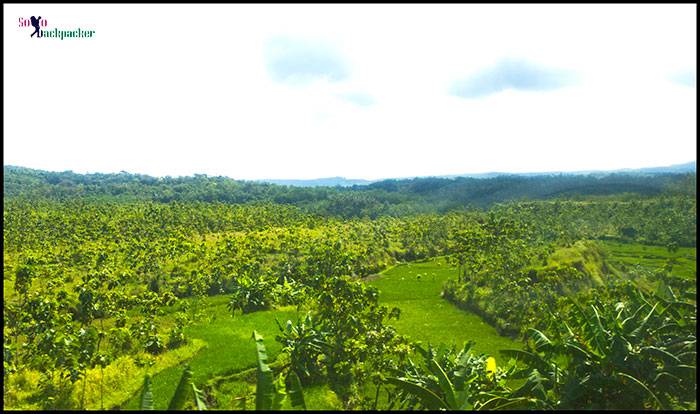
The train passed through small river streams, large water bodies, small villages and bigger towns. Because of its closeness with the equator, the Rice cultivation is an integral part of the Indonesian culture. They typically have two seasons for rice cultivation, so, distinct stages of rice cultivation is visible in the different parts of the train journey. In one part, I could see the small paddies getting planted in the fields while in the other parts, fully grown rice was ready to harvest.
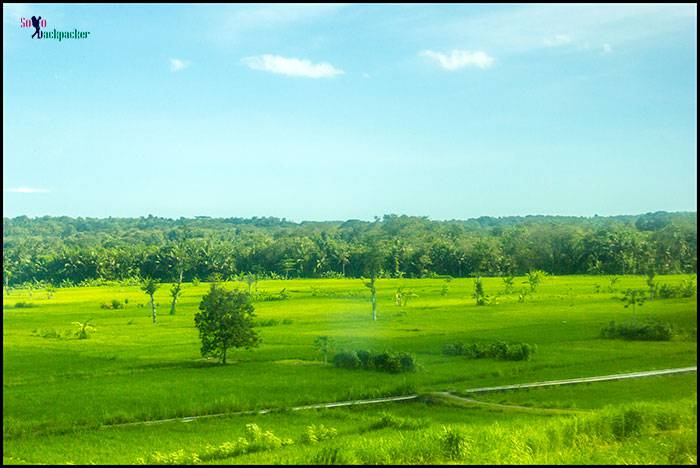
The train arrived in Yogyakarta at 0300 PM. Yogyakarta, the cultural capital of Indonesia, where most visitors are drawn to experience its two famous monuments, the Buddhist Borobudur Temple and the Hindu Prambanan Temple. Mount Merapi, the sacred volcanic mountain, is an additional reason to visit Yogyakarta.
6. Few More Points
1. Passengers are required to bring an original ID Card (Passport in case of Foreign Nationals).
2. Passengers are required to check in at least 1 (one) hour prior to the time of departure.
3. Redeem the ticket at least one hour before departure time at the counter or at the ticket printing machine. Please be reminded that the operational hours of the stations may vary.
4. Postponement, cancellation, or modification of journey can only be done at the nearest train station counter by showing the Passport for whom the ticket has been issued in the reservation system.
5. Cancellation can be done at least 30 minutes before departure time.
6. Refunds for cancellations will be reduced by 25% of the ticket price for administration fee.
7. Modification of the reservation can only be done once, at least one day before departure time.
8. It’s better to take foods and drinks with you.
9. Toilets may not look neat and clean. You have to bear with that. No other choice.
10. The baggage limit is 20 kg per person. However, normally there is no check. If it doesn’t look too bulky, then you can easily get through, else you have to pay the excess baggage fee.
11. The Trains in Indonesia, irrespective of their class and journey time, don’t have the sleeper berths.
12. Few Economy Class trains are equipped with the Fans instead of the Air Conditioners.
7. Onward Travel To Borobudur
After exiting from Lempuyangan station (from the main entrance) in Yogyakarta, walk for 800 meters to TransJogja bus stand (Halte TJ Yos Sudarso). From there, you can get bus number 5B or 2A directly to Jombor Terminal.
From Jombor Terminal, you can get a direct bus to Borobudur (38 kms) during the day-time. However, when I reached at Jombor terminal at about 0400 PM, there was no direct bus available for the day. If a direct bus is not available, then you can take a public bus to Muntilan (22 kms) and from Muntilan, you can hire a taxi to Borobudur. I did the same during my trip to Borobudur.
Read about the iconic temple of Borobudur: A Timeless Beauty in Java
If you plan to embark on a train journey from Jakarta to Yogyakarta, I hope this post will help you in the planning. If you find any information outdated, please let me know, so that I can update with the latest one. It will help the future travellers for a hassle-free exciting train trip from Jakarta to Yogyakarta.







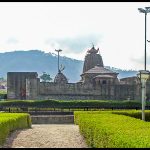
Hi
Very helpfull informations, I already felt in the train.
There is a problem with foreign Credit cards for payment, the transaction is denied…
Is it safe to send your id and copy of credit card to the booking compagny like tiket.com ?? I don’t think so
Thanx for your help
Regards from France
Thank You very much for a very Detailed Blog . Indeed very helpful.
You are welcome.:-)
Thank you for sharing all your information, you have compiled an extremely clear & useful guideline which has been very helpful
Thank you for the information.
I’m planning to go to Jakarta and Yogyakarta this July and your article is very helpful for a regular solo traveler like me
Hi, just want to let you know that since mid 2018, Indonesia offers 5 classes of trains. Apart from what you have mentioned (executive, business, economy), there’s priority class (like executive class with audio video on demand and free meal, snacks). And the last one is Luxury /Sleeper class, similar with priority but sleeper, you can imagine business class in flight but this one on train. Review videos available on Youtube but all reviewer are Indonesians.
Priority and Luxury class however, only offered in select route and time..
Very comprehensive, thanks for everything, please keep up the good work
Hi thank you for the itinerary, im planning to go in yogyakarta next year sep 2018. im a female solo traveler. is it safe to ride in train solo?
Yes, It’s perfectly safe to travel by train in Indonesia. You may find most of the female travelers boarding the train. Have a nice trip 🙂
hi this is anita again and surprisingly we are planning indonesia this year . need to know your diving experience in bali and jili
thanks.by d way i have done only 15 dive so far in andaman and red sea . is there too much current in bali/
what spot u have dived in bali n jili?
didi u went to mt bromo ? did u buy internal air tckt prior ur trip?
thanks
anita